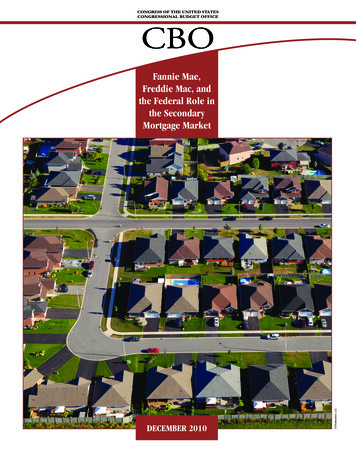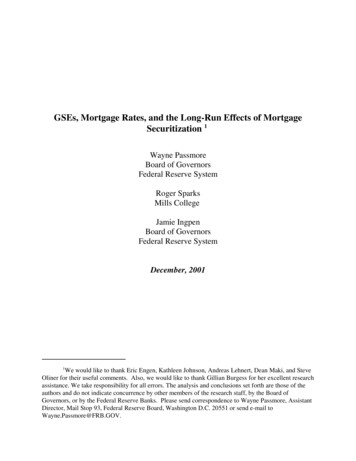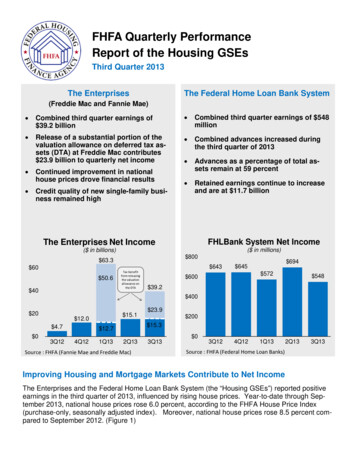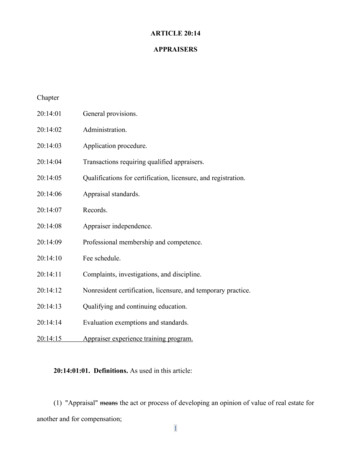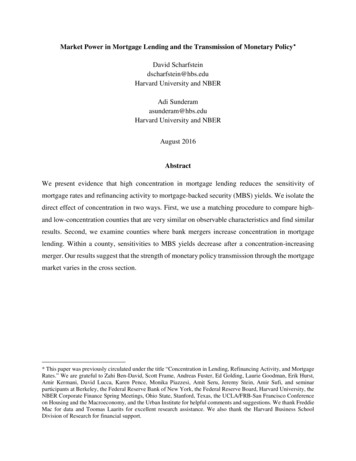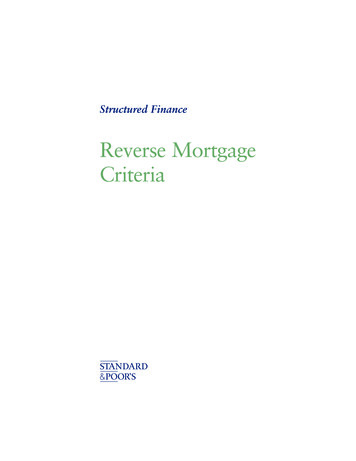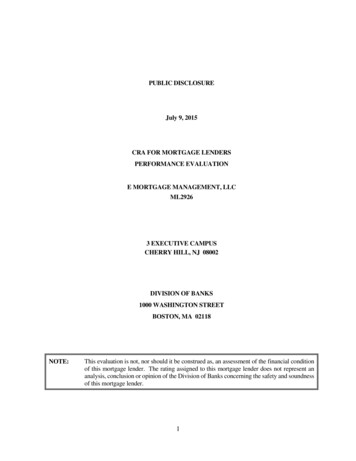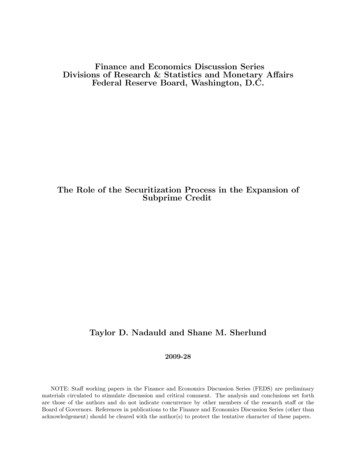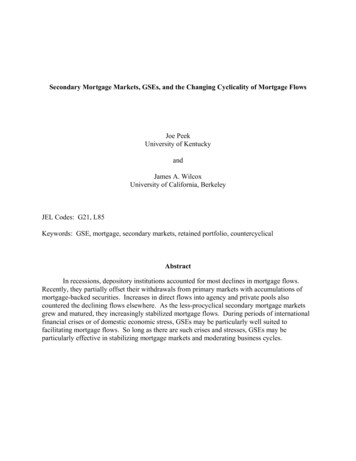
Transcription
Secondary Mortgage Markets, GSEs, and the Changing Cyclicality of Mortgage FlowsJoe PeekUniversity of KentuckyandJames A. WilcoxUniversity of California, BerkeleyJEL Codes: G21, L85Keywords: GSE, mortgage, secondary markets, retained portfolio, countercyclicalAbstractIn recessions, depository institutions accounted for most declines in mortgage flows.Recently, they partially offset their withdrawals from primary markets with accumulations ofmortgage-backed securities. Increases in direct flows into agency and private pools alsocountered the declining flows elsewhere. As the less-procyclical secondary mortgage marketsgrew and matured, they increasingly stabilized mortgage flows. During periods of internationalfinancial crises or of domestic economic stress, GSEs may be particularly well suited tofacilitating mortgage flows. So long as there are such crises and stresses, GSEs may beparticularly effective in stabilizing mortgage markets and moderating business cycles.
Congress chartered the Federal Home Loan Mortgage Corporation (Freddie Mac) and theFederal National Mortgage Association (Fannie Mae) as housing-related, government-sponsoredenterprises (GSEs). The missions of Fannie Mae and Freddie Mac are to: (1) promote the flowof capital to residential mortgage markets and (2) stabilize residential mortgage markets byfacilitating “a continuous supply of mortgage credit for U.S. homebuyers in all economicenvironments” (Federal Home Loan Mortgage Corporation 2000).Numerous studies have concluded that Freddie Mac and Fannie Mae raisedhomeownership rates by promoting the flow of capital to (residential) mortgage markets. Byproviding guarantees of the timely payment of principal and interest on mortgages, Freddie Macand Fannie Mae have contributed mightily to the development of secondary markets inmortgages (McCarthy and Peach 2002). Secondary mortgage markets, in turn, have increasedthe efficiency and liquidity of primary mortgage markets and the integration of U.S. mortgagemarkets into world capital markets (Devaney and Pickerill 1990, Federal Reserve Bank ofMinneapolis 2001, Goebel and Ma 1993, Rudolph and Griffith 1997). Apart from the reductionsin mortgage interest rates generally that may be attributed to the maturation of secondarymarkets, interest rates on conforming mortgages averaged a bit more than 25 basis points lowerthan those on jumbo mortgages before the 1990s, and a bit less than 25 basis points lower sincethe middle of the 1990s (Hendershott and Shilling 1989, Congressional Budget Office 2001).The total lowering of mortgage interest rates attributable to GSEs benefited homeownerssubstantially. By increasing the aggregate, longer-term supply of mortgage credit, and therebylowering mortgage interest rates and raising homeownership rates, GSEs can be said to haveachieved the first part of their missions.
Less attention has been devoted to the second aspect of the GSEs’ public missions. Thevolumes of assets and trading associated with secondary mortgage markets and the GSEs,anecdotal evidence, and introspection support the hypothesis that large, active secondarymortgage markets have altered the procyclicality of residential mortgage flows andconstruction.1 Nonetheless, in spite of the widely held view that the mortgage markets nowoperate fundamentally differently, little systematic evidence exists that secondary mortgagemarkets have altered mortgage flows during recessions.2In contrast to the studies about GSEs that predominantly focus on the average effects ofGSEs on mortgage rates, here we focus on fluctuations in mortgage flows at depositoryinstitutions and at other private sector suppliers of funds, as well as at GSEs. In particular, wequantify how much these total mortgage flows changed during national economic recessions.We calculate how much the flows of mortgage funds that were provided by depositoryinstitutions, pensions, insurance companies, and other suppliers of mortgage funds changedduring recessions. We calculate how much GSEs intermediated mortgage flows duringrecessions, how their intermediation compared with others’, and how it shifted through time. Ofspecial interest to us was how much, or even whether, GSEs offset others’ declines in mortgageintermediation and thereby stabilized the aggregate supply of mortgage credit during recessions.By stabilizing mortgage flows, Freddie and Fannie could dampen fluctuations in realactivity, both in the housing sector and in the macroeconomy.3 For that reason, which standsquite apart from their continuing value to the longer-term operation and development ofsecondary mortgage markets, the housing GSEs may contribute to the broader aims of publicpolicy.2
How can GSEs stabilize mortgage flows? First, they may directly increase mortgageflows during recessions by purchasing whole mortgages and mortgage-backed securities to atleast partially offset the procyclicality of supplies by others. GSEs may be more willing or ableto act countercyclically than the private sector because they have “deeper pockets.” Second,GSEs may reduce the procyclicality of other mortgage suppliers indirectly. One way to do thatis to make mortgages more attractive to less-procyclical investors. The expansion of secondarymarkets, the increase in their liquidity, and the implicit government guarantee of GSEs’obligations are likely to have attracted more funds both from foreign investors, whose homebusiness cycles are imperfectly correlated with those of the United States, as well as fromsectors, such as insurance and pension funds, whose shares of whole mortgages held had been inlonger-term decline.Large, active secondary mortgage markets may alter financial and real magnitudes inhousing markets during recessions for several reasons. The first revolves around differencesbetween the average riskiness of home mortgages and of business loans in bank (and thrift)portfolios. Bank portfolios consist of investments, mortgages, and other, primarily business,loans. Home mortgages tend to have lower expected default rates and risk premiums than theaverage bank loan. During recessions, the default rates and associated risk premiums in theirinterest rates for business loans tend to increase relative to those for home mortgages. Sincedepository institutions’ costs for their own liabilities reflect their entire portfolios, the risk-basedspread between the secondary market yield on mortgages and depository institutions’ liabilities’costs may shrink during recessions, thereby reducing the quantity of mortgages demanded bydepository institutions. Secondary mortgage markets can cushion declines in mortgage flows3
during recessions, then, by absorbing the mortgages that depository institutions are willing tooriginate but not hold.Typically, recessions are preceded by tighter monetary policy in the form of significantlyhigher short-term interest rates. Secondary mortgage markets may reduce the declines inmortgage flows attributable to higher interest rates, and therefore reduce the extent to which totalhome mortgage flows decline during recessions. When tighter monetary policy reduces thesupply of their less expensive, “core” deposits, depository institutions’ funding costs rise relativeto secondary mortgage market yields. By absorbing more mortgages, secondary mortgagemarkets can cushion housing markets when depository institutions accumulate mortgages ontheir balance sheets more slowly.Recessions can also result from disruptions to financial markets. Disruptions stem fromvarious sources. Contributing to the severity of the 1990-1991 recession, for example, was the“bank capital crunch,” during which loan losses reduced banks’ capital enough to reduce theirsupplies of credit, including mortgage credit. Banks can ease capital constraints by securitizingor selling mortgages that they have on their balance sheets. Given the structure of the Baslecapital regulations, secondary mortgage markets likely cushion mortgage flows against bankcapital shocks by enabling banks to convert whole mortgages into secondary mortgage marketsecurities that have a lower capital requirement, thus “stretching” bank capital. Thus, whenhousing-related GSEs increase their supplies of mortgage activities in response to financialdisruptions, they serve as shock absorbers that lessen the fall-off in the supplies of homemortgages.GSEs may act either as conduits to ultimate holders of home mortgages or as the ultimateholders themselves. An increase in GSEs’ holdings of home mortgages further mitigates the4
decline in depository institutions’ supplies of mortgage credit. In that way, secondary marketsfor guaranteed mortgages play the role that some envisioned for Fannie Mae and Freddie Macafter the mortgage credit crunch associated with disintermediation from depository institutions inthe 1960s.In this paper, we provide evidence that, as secondary mortgage markets grew, theprocyclicality of primary mortgage markets diminished. The next section provides backgroundon the growth of the secondary mortgage market and of two mortgage-related GSEs. The thirdsection focuses on the (pro-) cyclicality of mortgage flows. The fourth section compares flowsof mortgages across recessions. The final section summarizes our findings and suggests fruitfuldirections for further research on the effects of secondary mortgage markets on the financial andreal sides of housing markets.1. Direct and Indirect Holdings of Mortgages by the Private Sector and GSEsTwo basic activities of Fannie Mae and Freddie Mac increase the supply of mortgagefunds: (1) providing credit guarantees and (2) investing in mortgages or mortgage-backedsecurities (MBS). The term “retained portfolio” generally refers to the sum of the wholemortgages plus the MBS that Fannie Mae and Freddie Mac each hold. After purchasingmortgages, Fannie Mae and Freddie Mac can either (1) securitize the mortgages upon which theyhave placed their credit guarantee by issuing guaranteed MBS and then sell these securities toinvestors or (2) retain these mortgages for their own portfolio.4 Fannie Mae and Freddie Macfund their holdings of mortgages and of MBS by issuing non-mortgage-backed securities.When they retain mortgages or issue guaranteed MBS, Freddie and Fannie assume thecredit risk associated with the mortgages. Unlike providing credit guarantees, the retainedportfolio imposes interest rate and prepayment risks on Fannie Mae and Freddie Mac. Fannie5
Mae and Freddie Mac mitigate these risks with derivative financial instruments. The revenues toFannie Mae and Freddie Mac differ across the basic two activities: Fannie Mae and Freddie Macreceive a guarantee fee for the mortgages that they securitize, while they earn the differential ofthe yields on their retained portfolio above those of their own liabilities.The market for MBS developed slowly, beginning in the early 1960s with the issuance ofsecurities backed by pools of Farmers’ Home Administration (FmHA) mortgages. Theoutstanding stock or volume of these pools did not reach 1 billion until late 1968. Growth ofmortgage pools accelerated in the 1970s after the Government National Mortgage Association(Ginnie Mae) and Freddie Mac began pooling mortgages in the early 1970s. Growth acceleratedagain in the early 1980s after Fannie Mae and the private sector began to pool mortgages. Theoutstanding volumes of both GSE pools and private mortgage pools again grew rapidly in theearly 1990s, a time when the total volume of mortgages outstanding grew slowly. The absenceof the typical decline in total mortgages during the 1990-91 recession coupled with the largeincrease in the size of secondary markets suggests that secondary markets somewhat reduced theeffects of recessions on mortgage flows.Figure 1 plots quarterly data for MORTBAL, which is the outstanding total of residentialmortgage balances, as a percentage of (nominal) potential GDP for 1968Q1-2001Q3.5MORTBAL is clearly procyclical, declining during the 1970, 1974-75, and the two 1980srecessions. However, during the 1990 recession and the ensuing slow recovery, the total dollarstock of mortgages outstanding grew at about the same rate as GDP, rather than following itstypical procyclicality. Idiosyncrasies of the 1990-91 recession, such as the favored treatment ofmortgages and agency securities by the 1988 Basle Accord, may explain the missing6
procyclicality of MORTBAL. Alternatively, MORTBAL may have become less procyclical as aresult of the maturation of secondary markets for mortgages.Insert Figure 1 here.Figure 2 plots holdings of whole mortgages by Fannie Mae (DFANNIE) and FreddieMac (DFREDDIE), as a percentage of potential GDP. Fannie Mae acquired whole mortgagesrapidly during the 1970s. Since then, DFANNIE has been nearly trendless. DFANNIEfluctuates considerably over shorter spans. Relative to potential GDP, Fannie Mae’s holdings ofwhole mortgages peaked near each of the recessions since the early 1970s. Freddie Mac’sholdings of whole mortgages relative to potential GDP, DFREDDIE, were smaller and fluctuatedless than those of Fannie Mae. DFREDDIE, too, peaked in the mid-1970s, in the mid-1980s, andin the early 1990s. In contrast to DFANNIE, DFREDDIE did not rise as much during the tworecessions at the beginning of the 1980s. Note that Figure 2 plots data only for holdings ofwhole mortgages, and therefore ignores the growing holdings by Fannie Mae and Freddie Mac ofMBS and the growing volume of guaranteed MBS held outside the GSEs.Insert Figure 2 here.Figure 3 plots total residential mortgage intermediation by Fannie Mae (TFANNIE) andFreddie Mac (TFREDDIE), calculated for each GSE as its holdings of whole mortgages plus itsguaranteed MBS outstanding. Figure 3 also plots the intermediation by private mortgageconduits (TPRIVATE), calculated as the sum of private (i.e., not guaranteed by a GSE) MBS.Data for each series in Figure 3 are expressed as a percentage of potential GDP for 1968Q1 –2001Q3. TFANNIE and TFREDDIE grew quite slowly until the early 1980s. Both thenaccelerated. Thereafter, TFANNIE maintains its rapid growth rate. While TFREDDIE grewmore rapidly than TFANNIE through the mid-1980s, it grew more slowly for the ensuing7
decade. Clearly, GSEs accounted for the overwhelming share of growth in total intermediationuntil the early 1990s. But, once secondary markets became well established, non-GSE issuanceof MBS grew rapidly, too: TPRIVATE grew relatively slowly through the 1980s, but thenaccelerated in the 1990s to growth rates similar to those of TFANNIE and TFREDDIE.Insert Figure 3 here.Figure 4 plots total mortgages outstanding and total intermediation by GSEs, eachrelative to potential GDP. FANFRED is the sum of total residential mortgage intermediationactivities by Fannie Mae and Freddie Mac, calculated as the sum of TFANNIE and TFREDDIEfrom Figure 3. MORTBAL is the total residential mortgage balances outstanding series fromFigure 1. DIFF, calculated as the difference between MORTBAL and FANFRED, measures thevolume of mortgages that do not pass through Fannie Mae or Freddie Mac.Insert Figure 4 here.After having been approximately trendless until the early 1980s, MORTBAL rises byabout 20 percentage points, or about 70 percent, through the end of the period. From 1968through 2001, DIFF was approximately trendless. By contrast, FANFRED rose from near zeroto about 20 percent since the late 1960s. Thus, the major, longer-term increase inhomeownership, as measured by mortgages relative to potential GDP, coincided not with anincrease in DIFF, but rather with a strikingly similar increase in the extent to which GSEsparticipated in mortgage markets. Such evidence supports the notion that the housing GSEshave succeeded in the first part of their missions.The second part of their missions is to stabilize mortgage finance. Figure 4 shows that,until about the mid-1980s, fluctuations in MORTBAL coincide impressively with fluctuations inDIFF, the mortgages not held or securitized by the GSEs. And, the fluctuations in both series8
were visibly procyclical. Although the procyclicality of DIFF appears unabated, MORTBALseems much less procyclical after the mid-1980s for two reasons. First, the upward trend inFANFRED offset the contributions of DIFF to the procyclicality of MORTBAL. And, second,FANFRED itself seems to have been somewhat countercyclical: Its growth was somewhat fasterduring the macroeconomically weaker periods of the early 1990s and early 2000s and somewhatslower during the macroeconomically stronger periods of the late 1980s and mid-1990s.2. The Declining Procyclicality of Mortgage FlowsFigure 4 illustrated that total residential mortgages outstanding were clearly procyclicalprior to the 1990s, but much less clearly so after 1990. An important issue is to what extent thetwo housing GSEs offset the reductions in supplies of mortgage credit by others duringrecessions. To the extent that Fannie Mae and Freddie Mac operated countercyclically, theystabilized mortgage flows and likely the macroeconomy as well.Table 1 shows the changes in total residential mortgage balances and the changes in(total) intermediation by Fannie Mae and Freddie Mac for the five most recent recessions. Theseare the five recessions that have occurred since Fannie Mae and Freddie Mac became substantialparticipants in secondary mortgage markets. Table 1 also shows the difference between thosetwo series and the averages across the five recessions for each series in Table 1. Recessionperiods in Table 1 span the quarters that contain the peak and trough months designated by theNational Bureau of Economic Research (NBER). As of January 2003, NBER had not yet chosenthe month for the trough of the recession that began in 2001.Insert Table 1 here.The comparison period associated with each recession was based on seasonally adjusted,quarterly data for total flows of home mortgages. These data came from the Flow of Funds9
accounts of the Board of Governors of the Federal Reserve System. Data for mortgage flowswere expressed as a percentage of potential GDP.Tables 1-4 focus on changes in mortgage flows during recessions. That is, they focus oncyclical rather than trend-like developments. In Table 1, each comparison period spans theperiod from the calendar quarter that contains the (local) maximum flow of total homemortgages that occurred just prior to the national economic peak quarter to the calendar quarterwith the ensuing (local) minimum flow of total home mortgages. Measured this way, thecomparison period spans the period of peak to trough in the flow of total home mortgages. Table1 shows that the trough in mortgage flows occurred in either the quarter of the trough in thenational economy or the quarter immediately prior for the four recessions for which trough datesare available.We expected most financial and economic stocks and flows to decline (relative topotential, rather than actual, GDP) during recession or comparison periods. We also expectedthat the longer or more severe the recession, the larger the decline during that recession or itscomparison period. Those patterns show up in Table 1. Table 1 shows that total residentialmortgage balances fell during the longer and more severe recessions of 1973-75 and 1981-82.During the 1990-91 recession, which was less severe, total balances declined by a smalleramount. During the 1980 recession, which was very brief and anomalous for having been muchinfluenced by government-induced credit controls, total mortgage balances actually rose by asmall amount. By contrast, during the most recent recession, which began in 2001, totalresidential mortgage balances actually rose considerably, increasing by over one full percentagepoint of potential GDP during the middle of 2000.10
Here we use the standard that cyclicality is measured by changes in financial quantitiesrelative to potential rather than to actual GDP. On average over these five recessions, totalresidential mortgage balances fell by 0.69 percent of potential GDP. By that measure, totalbalances were procyclical. The procyclicality of total balances has waned, however, throughtime. During the 1990-91 recession, total balances fell by only 0.16 percent. And, during themost recent recession, total balances actually rose by 1.11 percent, which is about ascountercyclical as the average decline for the first four recessions in Table 1 of 1.14 percent wasprocyclical. Thus, total balances, and thus presumably mortgages and real activity in housingmarkets, have become much less procyclical over the postwar period.Table 1 next shows that total intermediation by Fannie Mae and Freddie Mac duringrecessions has typically been countercyclical. It also shows that GSE intermediation has beenincreasingly countercyclical. The two rows under the row labeled TOTAL show the changes inthe components of TOTAL. The row labeled GSE contains data for the changes in totalintermediation by Fannie Mae and Freddie Mac. These data are based on the data used forFANFRED in Figure 4.Having increased during (the comparison period associated with) each recession,intermediation by Fannie Mae and Freddie Mac combined was countercyclical. On average, thecombined total intermediation rose by 0.71 percent of potential GDP. During the two mostrecent recessions, it rose by an average of 1.1 percentage points, which is more than twice asmuch as it rose on average (0.44 percentage points) during the three prior recessions. Bycontrast, the non-GSE portion of mortgage intermediation, calculated as TOTAL – GSE, fell ineach but the most recent recession. These declines mean that, taken together, the behavior of theother participants in the mortgage market was procyclical. Nonetheless, non-GSE11
intermediation has also become notably less procyclical recently. Whether that decline inprocyclicality is connected to increasingly countercyclical total intermediation by GSEs is aquestion worthy of further investigation.The bottom panel in Table 1 shows the changes in the components of total balancesrelative to changes in total balances. Thus, the sums of the data in the first two rows of thebottom panel equal 100 percent. The data in the rightmost column in both the top and bottompanels show that, on average over these five recessions, total intermediation by Fannie Mae andFreddie Mac rose by half as much as non-GSE holdings declined. In that sense, Table 1indicates that the countercyclicality of Fannie Mae and Freddie Mac offsets half of theprocyclicality of others.To further investigate the cyclicality of GSEs and others, we used the Federal Reserve’sFlow of Funds accounts (FOF) to obtain data for the flows of home mortgages that aredisaggregated by sector of holder. The FOF data show the major holders of home mortgages bysector, but do not similarly show holdings of MBS by sector. To approximate holdings of MBSby sector, we used FOF data for holdings of agency securities. These data overstate holdings ofMBS by sector and overstate the direct obligations of Fannie Mae and Freddie Mac. The sum ofMBS issued by agencies plus the bonds, notes, and short-term debt issued by Fannie Mae andFreddie Mac accounts for nearly all of the total stock of agency securities. On the other hand,the data for agency securities exclude the large and growing stock of MBS that has been issuedby the private sector.We used data for direct holdings (of whole mortgages) and direct-plus-indirect holdings(i.e., holdings of whole mortgages plus MBS) in Tables 2 and 3. In addition to the recessionsanalyzed in Table 1, Table 2 includes data for the other postwar recessions and data for the 196612
credit crunch, which is the only non-recession period when the flow of total home mortgages(relative to potential GDP) declined for at least four consecutive quarters. (Hereafter, we includethe 1966 credit crunch in the set of postwar recessions). Because quarterly flows of mortgagesare so volatile, for Tables 2 through 5 we calculated changes in the two-quarter averages offlows by first-differencing the seasonally adjusted, net flows (relative to potential GDP) of directholdings of home mortgages by each holder.Insert Table 2 here.The comparison periods span the quarters with the peak and trough flows for total homemortgages (relative to potential GDP). We calculated the first-differences reported in Table 2 bysubtracting the average value for the minimum flow quarter and the quarter preceding theminimum flow quarter from the average value for the maximum flow quarter and the higher ofthe two adjacent quarters. The two exceptions are that a single quarter is used for the minimumflow quarter for both the 1980 recession, because it was immediately followed by the nextrecession comparison period, and the 2001 recession, because the total home loans series rosestrongly after 2000Q4.Table 2 shows changes in the flows of holdings of whole home mortgages for eachrecession, for the 1966 credit crunch, and on average over the most recent five recessions. Table2 shows changes in total flows (ALL HOLDERS) and changes in the flows for each of tensectors. The sectors are depository institutions (D-DEP), which includes the commercialbanking sector, savings and loans, and credit unions; nondeposit financial institutions (DNDEPFIN), which includes finance companies, mortgage companies, REITs, money marketmutual funds, mutual funds, and brokers and dealers; insurance companies (D-INS), whichincludes life insurance companies and other insurance companies; pensions (D-PENS), which13
includes private pension funds and state and local government retirement funds; nonfinancialcorporate business (D-NFCORP); households (D-HH); government (D-GOVT), which includesthe federal, state, and local governments; government-sponsored enterprises (D-GSE); federallyrelated mortgage pools (D-POOL); and private issuers of asset-backed securities (D-ABS).Table 2 shows that the flow of home mortgages to all holders declined during eachrecession. Over the most recent five recessions, the decline averaged two percent of potentialGDP. Depository institutions reduced the rate at which they acquired whole mortgages in eachepisode. In fact, over the most recent five recessions, the average decline for depositoryinstitutions was larger than that for all holders. In contrast, on average over the five most recentrecessions, countercyclicality was most prominent among issuers of MBS: federally relatedmortgage pools and private sector issuers of MBS. Although the other Federal Reserve dataused for Figures 1-4 and for Table 1 allowed it, FOF accounts data did not allow us to separatedata for Fannie Mae and Freddie Mac from the reported aggregate data for all GSEs.Table 3 shows data for changes in flows of direct-plus-indirect holdings of homemortgages. Indirect holdings consisted of MBS. This table, as well as Table 5 below, includesthe foreign sector (FOREIGN), which had no whole mortgages reported in the FOF accounts andthus was omitted from Table 2. The data for the ALL HOLDERS row is from Table 2. As withdirect holdings, direct-plus-indirect holdings by depository institutions accounted for most of thedeclines. Thus, in Table 2 and Table 3, depository institutions were generally the mostprocyclical holders of mortgages. Households were typically procyclical, too, as were thegovernment and nonfinancial corporate sectors. The most countercyclical sectors were thefederally related mortgage pools, GSEs, and private issuers of MBS. In Table 3, GSEs14
contributed more to countercyclicality than in Table 2 because of the rapid growth of theirholdings of MBS.Insert Table 3 here.Table 4 re-expresses the flows in Table 2 relative, not to potential GDP, but rather to thechanges in flows of total home mortgages. That is, for Table 4, the numerators in Table 2 weredivided by the changes in flows to all holders. Since this denominator was negative for eachrecession, positive entries in Table 4 show the shares of the declines in the total flows associatedwith a sector. Negative entries indicate the percent of the change in the total flows that wasoffset by a sector.Insert Table 4 here.In five of the ten recessions, depository institutions accounted for more than 100 percentof the decline in the flow of total home mortgages. In the most recent recession, they accountedfor more than twice the actual decline in the flow of total home mortgages. The contrast with theactions of federally related mortgage pools is particularly striking. During the most recentrecession, the increase in the flow of home mortgages to federally related mortgage pools rosesignificantly. In fact, the increase in the pools’ rate of acquisition of home mortgages was fargreater than the net decline in the flow of total home mortgages.Table 5 re-expresses the flows of the sum of direct-plus-indirect holdings of homemortgages relative, not to potential GDP, but rather to the changes in flows of total homemortgages. Even with this broader measure, depository institutions remain very procyclical, onaverage accounting for 105 percent of the declines in total mortgage flows over the five mostrecent recessions. By this broader measure, households are significantly procyclical, on averageaccounting for about one-third of the declines over the five most recent recessions. Although15
they had no consistent pattern before that, the large negative entry for non-depository financialinstitutions for the most recent recession shows that they partially offset the procyclicality ofdepositories. By the broader measure of mortgage flows in Table 5 that included their holdingsof MBS, GSEs were more countercyclical than suggested by Table 4.Insert Table 5 here.3. Summary, Implications, and Future DirectionsThe housing-related GSEs have contributed to the growth and maturation of secondarymortgage markets. In doing so, they have contributed to higher, long-term homeo
In this paper, we provide evidence that, as secondary mortgage markets grew, the procyclicality of primary mortgage markets diminished. The next section provides background on the growth of the secondary mortgage market and of two mortgage-related GSEs. The third section focuses on the (pro-) cyclicality of mortgage flows.
